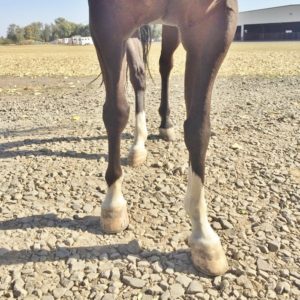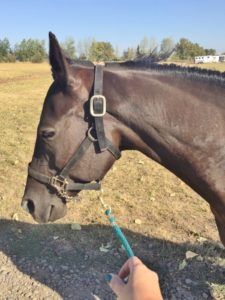Proceed with Caution
by Theresa Rice

My horse recently injured himself, clipping the inside of his back leg with his other hoof (he’s almost as graceful as me). It looked like a simple flesh wound, so I hosed it down and put him up for the night. The next day the wound had scabbed over—a nickel sized scab—and I thought nothing of it.
On the third day I came to the barn to find his leg swollen halfway up his cannon bone and down into his fetlock and coronet band. I was so disappointed! I hadn’t been hosing his leg because the wound healed up fine and it looked so minor. So I spent the next 14 days hosing down his swollen leg, hand walking him, and turning him out in a small pen so he could move freely but not so freely that he could reinjure himself.
Although horses are large animals, they are also fragile and sensitive creatures. My horse’s wound, and the swelling, healed with time and patience. But what comes after the injury appears to be healed? The temptation is strong to hop back on like no time has passed; I mean really, what’s two weeks? We do our equine partners a favor if we slowly build back up to their pre-injury workload.
The first day back to work I lunged Gangster at a jog for 10 minutes, then rode him at a walk for 5 minutes and a jog for 10 minutes. I then hosed his leg down. I worried I would come out the next day and see the leg was stocked back up, but it wasn’t.

The following night I rode him for 30 minutes —20 at a walk, 10 at a jog. Even though I felt he had the energy to go galloping across the field, I held him back. Muscles and ligaments that have been at rest are not in condition for such pounding, and it would risk reinjuring the soft tissue around his original cut.
With any major injury, your vet will advise you on when it’s safe to get back in the saddle. They will also advise you on how long you can ride each day to slowly build your horse back into condition. When an injury doesn’t require a vet’s attention, it is still wise to slowly develop your horse’s workload. The point is to strengthen his endurance, working at a slower pace for longer and longer intervals.
Waiting for your horse to get back to his pre-injury fitness can be a frustrating experience. To make things more interesting I suggest getting out of the arena. If you’re bored, there’s a good chance your horse is too. There’s more to look at outside, uneven surfaces to contend with, and even some obstacles to challenge your horse’s brain. You can test your horse’s trail savviness by setting up a few obstacles that can be navigated at a walk. You can do this by laying down a tarp and coaxing your horse to walk across it. You can also set up a kiddie pool filled with used water bottles, exposing your horse not only to the visual challenge, but also the sensation of walking on the bottles and the sound it produces. Even when you can’t work at a fast speed or for long periods, you can still find ways to challenge both of your brains.
When it comes to injuries, everyone has an opinion. Trust your gut and what you know is normal for your horse. If you’re not comfortable watching and waiting, call your vet and get a professional opinion. If nothing else, the vet’s perspective will give you peace of mind and you’ll know the plan for your horse’s road back to health is endorsed by the vet. Patience with a healing injury will always lead to a better long-term outcome. Best of luck, and may your hooves always be sound.

Theresa grew up riding horses off and on throughout her life, finally fulfilling her dream of horse ownership in 2012. She is currently working on her first novel, inspired by her time spent working on a guest ranch in Arizona where she met her husband. They married in 2012. When not writing, you can find her riding her half-Arabian gelding, Gangster, or chasing after her two German Shepherds. website: www.sassinboots.com








